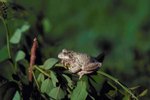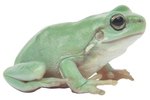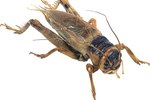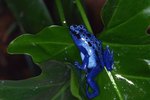
Among the thousands of frog types in the world, many are brown or green, which allows them to blend in well with their surroundings. Several kinds of frogs change colors. Various factors can cause this, such as outdoor temperature, brightness of light and moistness of the air. Even their emotions, such as excitement or anxiety, can cause their bodies to change color. Frogs also go through this adaptation when they need to protect and camouflage themselves among their surroundings. Chromatophores are frogs' pigment cells that allow their bodies to change colors.
Spring Peeper
The spring peeper's name results from this frog's tendency to start calling around the time of the spring equinox. Although just 1 to 1.5 inches long, the spring peeper emits a loud and high-pitched sound that resembles an insect chirping or a sleigh bell. Its body color is light brown, similar to tree bark, and it darkens in color based on its moods or to blend in with its environment. It can lighten in color at night.
African Clawed Frog
The African clawed frog does not have a tongue, and males do not have vocal sacs, whereas most other male frogs do have vocal sacs. The hind legs' inside toes have tips resembling claws that give the frog its name. Males are between 2 and 2.5 inches long, and females are between 4 and 4.5 inches long. These frogs, which live in various areas of Africa, can darken in color when they are disturbed and can change coloring to speckled, light or dark as an adaptation to their surroundings.
Gray Tree Frog
Gray tree frogs can grow up to 2 inches long, with females being larger than males. These tree-dwelling frogs have blotches shaped like stars on their backs and spots under their eyes. As they change in color, they can range from being shades of gray, to green, brown or almost black.
Green Tree Frog
The nocturnal green tree frog lives in trees in the southeast part of the United States and when full grown is about 1.5 to 2 inches long. Its distinctive markings include a yellow- or light yellow-colored stripe extending from its head to its back legs. Some of these frogs also have yellow spots on their backs. Their colors range from brown to lime green, and what color they are at any given time depends on factors in their surroundings like brightness of light, temperature and humidity.
White's Tree Frog
Native to parts of Australia, New Zealand, New Guinea and Indonesia, the nocturnal White's tree frog has horizontal pupils instead of the vertical pupils that most other tree frogs have. The White's also has large toe pads and a fatty area above each eye. It can live in either humid or dry areas and is friendly around people. Males grow to about 3 inches long, and females grow to about 4 inches. This frog's vibrant skin ranges along the color spectrum from bright green to light, purplish blue as it adapts to its environment.
References
- Cleveland Museum of Natural History: Gray Treefrogs
- Minnesota Pollution Control Agency: Frogs for Kids
- Smithsonian National Zoological Park: African Clawed Frog Fact Sheet
- Rhode Island Vernal Pools: Spring Peeper
- Amphibian Care: Green Tree Frog
- Smithsonian National Zoological Park: White's Tree Frog Fact Sheet
- Exploratorium: Frogs--The Amazing, Adaptable Frog--Color and Camouflage
- My Pet Frog; Rennay Craats
- Animal Planet: Tree Frog
Photo Credits
-
Jupiterimages/Photos.com/Getty Images
Writer Bio
Judy Wilson has writing and editing expertise in health, technology, pets, business and travel. She has contributed to USAToday.com, SFGate.com and numerous other publications. Wilson earned a Bachelor of Arts in journalism and mass communication from the University of North Carolina at Chapel Hill, where she completed Mini Medical School.




